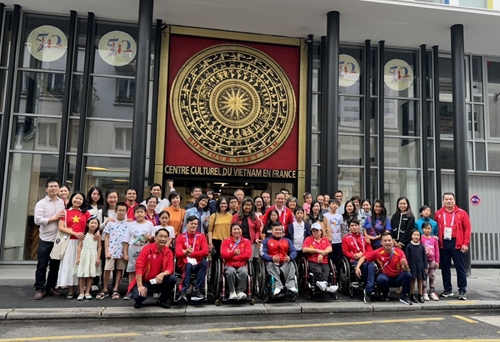From 1995 to 2007, the promotion of sports for people with disabilities in the country was in its early stage. However, even the first national competition held in Quang Tri in 1997 saw the participation of over 600 athletes. The domestic parasports movement has developed steadily while Vietnamese athletes have also gained a foothold at regional and international competitions.
    |
 |
|
The Vietnamese delegation participating in the Paris 2024 Paralympic Games |
In 2001, Vietnam sent 45 athletes to the first ASEAN Para Games, ranking fourth. At the second edition, hosted by Vietnam in 2003, the country quickly improved its performance to the second place overall and maintained this position at the third Games held in Manila, the Philippines, in 2005.
Since then, the sports movement among the disabled has expanded strongly nationwide, with 33 to 35 provinces/cities regularly sending athletes to national competitions which attract around 1,300 athletes.
Vietnam has also continuously asserted its position at the continental level. At the first Asian Para Games held in Guangzhou (China) in 2010, the Vietnamese delegation ranked 12th out of the 43 countries and territories, winning three gold, four silver, and ten bronze medals. At the 2014 Asian Para Games in Incheon (the Republic of Korea), achievements improved further, securing the 10th place among the 45 participating countries and territories, with nine gold, seven silver, and 13 bronze medals.
Beyond that, Vietnam has reached the global stage, making its name in the largest international multi-sport event for Paralympic athletes. At the 15th Paralympic Games in Rio de Janeiro (Brazil) in 2016, which featured 4,358 athletes from 162 countries and territories, the Vietnamese delegation competed in three out of 23 sports and secured remarkable success: one gold, one silver, and two bronze medals, ranking 55th overall. This was considered the greatest success so far for the Vietnamese parasports after 20 years of development.
Tran Duc Tho, General Secretary and Chief of the Office of the Vietnam Paralympic Committee, highlighted continuous improvements in the disabled's engagement in physical and sports activities. Sports clubs, private establishments and rehabilitation centers for people with disabilities, as well as education centers for less privileged children have increased and been consolidated.
Meanwhile, he added, the number of those who regularly undergo exercise and training at sports clubs exceed 8,000 each year. Notably, such localities as Ho Chi Minh City, Hanoi, Can Tho, Da Nang, Quang Ngai, Quang Tri, and Thai Nguyen record this figure at more than 30,000. Domestic competitions have also seen the increasing participation of associations and clubs for disabled persons, attracting about 1,200–1,300 athletes and coaches each year on average.
Affirming position with concrete goals
Concrete targets and measures have been outlined for Vietnam's parasports to reinforce its position and reach the world level by 2030.
From 2024 to 2030, to further promote the movement, the country aims for 70% of the provinces and cities nationwide having sports clubs for people with disabilities and accessible sports facilities.
It plans to popularize and develop at least 15 sports, including athletics, swimming, powerlifting, chess, table tennis, badminton, blind judo, taekwondo, archery, wheelchair tennis, dance sports, yoga, blind football (5-a-side), and esports, attracting 35,000 to 40,000 participants. The national championship system will be strengthened, with core sports like badminton, table tennis, powerlifting, athletics, swimming, chess, and pickleball, expecting over 1,300 athletes per year.
The country also prioritizes building a new generation of athletes through talent development programs at the provincial level. The goal is to maintain 55–60 elite athletes (adding 10–15 young athletes) receiving regular training at national and local sports training centers to prepare for international competitions.
At the regional, continental, and international levels, key targets include securing a top-four finish at the 13th ASEAN Para Games in Thailand, and winning a gold medal at the 2026 Asian Para Games in Japan. Loftier goals include qualifying seven to ten athletes for the 2028 Los Angeles Paralympics in three key sports: track and field, swimming, and powerlifting, with the goal of bringing home medals.
Focal solutions devised
To reach these goals and contribute to the implementation of Vietnam’s sports development strategy by 2030 with a vision toward 2045, certain shortcomings and challenges have been pointed out. Some provinces and cities have yet to fully recognize the benefits of sports in improving the lives of people with disabilities and contributing to social stability. While many leading nations in Paralympic sports have younger athletes with outstanding achievements and specialized training programs, Vietnam still lacks a strong pipeline of young athletes.
Tho said Vietnam’s para-athletes have a higher average age than their peers in the region, the continent, as well as the world. The country also lacks a steady source of young athletes. Many athletes suffer injuries during training and competition but do not receive thorough treatment, subsequently affecting their future performance.
To address these issues, authorities will focus on raising public awareness about the benefits of sports for people with disabilities, emphasizing physical and mental well-being, social integration, and self-empowerment. Collaboration with the Ministry of Education and Training, national sports organizations, and local clubs will be strengthened to develop grassroots programs, organize competitions, and provide more sports opportunities for the community.
Developing a high-performance sports system for people with disabilities, particularly by scouting and training young talent, is a key strategy. Additionally, mobilizing social resources will help sustain parasports development. Supporting athletes in their post-competition careers is also a priority, ensuring that sports serve as a true bridge for the disabled to integrate into society and take control of their lives.
Source: VNA